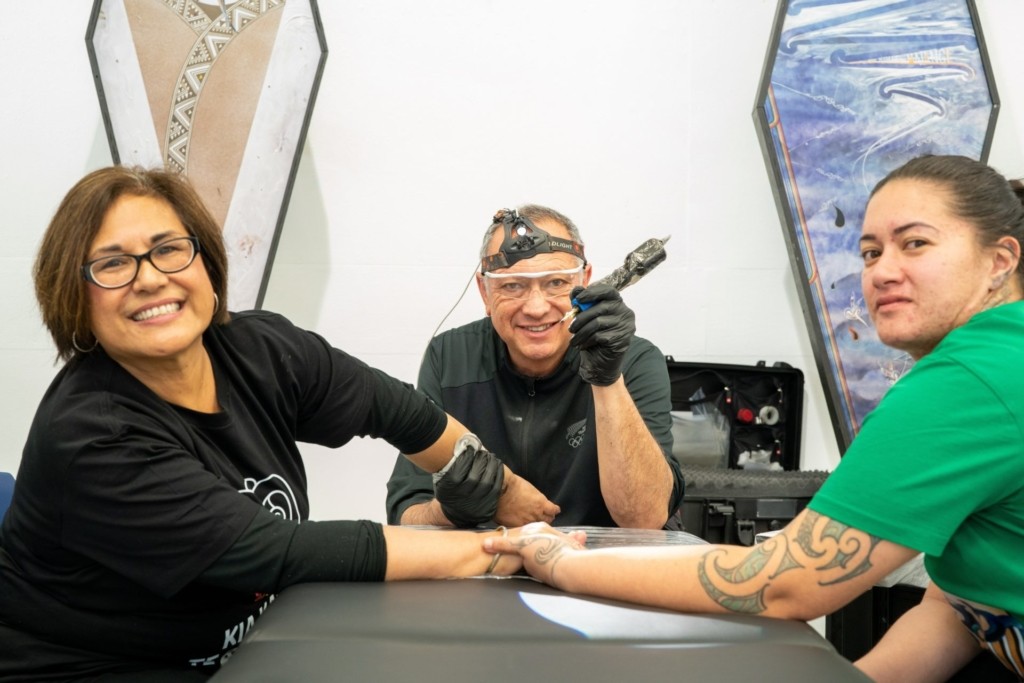
Tracey Tangihaere, Toihoukura Acting Head of School and Executive Director, Tairāwhiti (left) receives a moko from EIT Tairāwhiti Professor Sir Derek Lardelli (centre), while Lateesha Lerm looks on (right).
Tā moko was celebrated last week at the Tū ā Rangi Moko Wānanga held at Toihoukura – EIT’s Māori Visual Art and Design School in Tairāwhiti.
Led by renowned artist and EIT Tairāwhiti Professor Sir Derek Lardelli and members of Te Uhi a Mataora – which is a committee of Toi Māori Aotearoa – gathered to express their talent through the tradition of Tā moko.
Sir Derek says the wānanga, which was not able to be held for the past two years due to COVID-19, was an opportunity to discuss and share ideas about the moko movement including where it’s come from, the current state and future aspirations for the art form.
“As an art form, it has survived the trauma of colonisation, two World Wars, and the pandemic. Therefore, it is a taonga that knows how to survive”
“Part and parcel of our role as moko artists is to make sure that whatever we do, we maintain our integrity and our pride, and look after that taonga which has been bequeathed to us from our ancestors. We need to make sure that we leave it in a better place from where we found it.”
Tā moko is a means of expressing oneself and one’s culture, so holding it during Te Wiki o te Reo Māori week was perfect, Sir Derek says.
Te Reo plays a huge role in the tikanga surrounding the application of moko. Each day of the wānanga began with karakia, korero and waiata. Students, artists and manuhiri (visitors) were encouraged to use what reo they could.
One out of town visitor commented that she had not heard Te Reo flowing in casual conversation as it was at times during the wānanga. She said she felt privileged to be made to feel welcome, especially as a non-speaker of Te Reo herself.
The art form has grown exponentially over the last 20 years. In the last five years there’s been a huge revival in the moko art form across the country, often by moko artists who are Toihoukura graduates.
“There’s an enormous amount of satisfaction and pride in here because Toihoukura has made it a place for the art form to flourish and grow its wings.”
Sir Derek says bringing such artists to the school allows the opportunity for the students to be part of that multifaceted delivery.
“It allows for extension, not only for ourselves as moko artists, but for our students who are watching, listening, and taking in this wonderful indigenous pride and making use of it for themselves and for their whanau.”
The majority of artists present at the wānanga are graduates of Toihoukura.
Graduate Anthony (Fatty) Karauria says it was always an honour and a privilege to return to Toihoukura.
“It is an honour to be able to come back and support the Kaupapa, give back to the place that gave me my start as an artist, and tautoko the next generation of Māori artists.”
Tracey Tangihaere, Toihoukura Acting Head of School and Executive Director, Tairāwhiti , says exposure to the toi Māori world is beneficial to students.
“The priority is on creativity and giving students those resources to be creative and seek inspiration from other areas out of the environment and out of people whom they can engage with while they’re here.”
She was also on the receiving end, with her first moko completed by Sir Derek. Events like these, she says, sparks interest for the students in a particular pathway.
Toi Māori Tumu Whakarae (Chief Executive) Tamahou Temara says it was an easy decision to support Sir Derek’s vision and the kaupapa of the wānanga.
He says it is important to see the moko art form is healthy and listen to practitioners and how best they can support them. “moko is one part of the fabric of all the art forms they have.”
“The level of students that come out of Toihoukura has been phenomenal over the years.”

